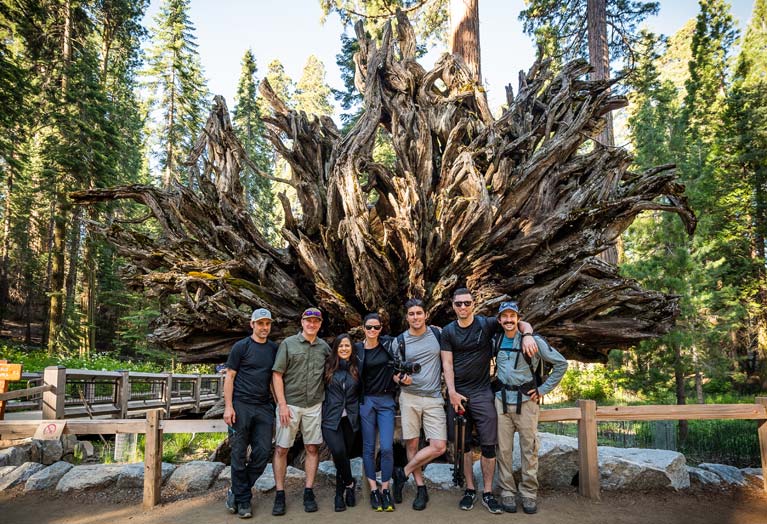
Mariposa Grove
The Mariposa Grove of Giant Sequoias is the largest and most impressive grove of redwoods in Yosemite National Park, containing approximately 500 mature giant sequoia trees (sequoiadendron giganteum). The oldest sequoias are estimated to be thousands of years old.
Visiting the Mariposa Grove
- The Mariposa Grove is located a short 4 miles from Tenaya at Yosemite.
- Expect to travel by shuttle bus from a parking area at the South Entrance Station (2 miles from Tenaya at Yosemite) to a shuttle stop in the lower Mariposa Grove.
- If you don’t want to wait for the shuttle, a hiking trail runs directly from the parking lot at the South Entrance to the lower grove (roughly 2 miles).

What to See
- Fallen Monarch – One of the first named trees when you enter the Mariposa Grove is the Fallen Monarch. This tree toppled centuries ago, but thanks to the tannic acid present in the wood, you can still see the giant halo of the root system. Don’t forget to leave no trace! Help preserve this centuries-old tree by remembering not to climb on the Fallen Monarch.
- The Grizzly Giant – This is one of the largest trees in the Mariposa Grove and is thought to be more than 1,800 years old. Looking up, it can be hard to fully appreciate the scale and mass of this sequoia. The large limb on the south side of the tree is nearly 7 feet in diameter alone. That one branch of the Grizzly Giant is larger than any non-sequoia tree in the grove.
- California Tunnel Tree – Just beyond the Grizzly Giant is the California Tunnel Tree. The tunnel was carved through the tree in 1895 to allow horse-drawn stages to pass through, and you can still walk through the tunnel today. The “tree you can drive through”, the Wawona Tunnel Tree, was further up in the grove, but fell over in the winter of 1968/69.
- Faithful Couple – Many people turn around after visiting the California Tunnel Tree, but for those interested in a longer walk, the Faithful Couple is about 0.5 miles past the Grizzly Giant. Two sequoia trees growing close to each other have merged over the years to form a single massive trunk.
- Clothespin Tree – If it seems amazing to you that people would carve tunnels in these amazing trees, keep walking until you come to the Clothespin Tree. This tree has a natural tunnel carved into its base as the result of many fires through the centuries. The natural opening at the base is wider than a car!
- The Upper Grove and Mariposa Grove Cabin – The trees in the upper grove, perhaps because of their proximity and the open areas between them, have a particular majesty and cathedral-like grace. For many, it’s their favorite part of the grove. The cabin in the upper grove occupies a site where Galen Clark, the “first guardian of Yosemite”, built a small cabin in 1861. Prior to the restoration, this building served as a small museum with information about the trees and the ecosystem surrounding them.
- Wawona Point – A spur trail leads 1/4 of a mile to Wawona Point; a beautiful overlook with views to the west and north.

Don’t Miss
- Sugar Pine Cones – Many people assume that because giant sequoias are the largest trees in the grove, they must also produce the largest cones. However, giant sequoia cones are small, measuring only a few inches in diameter. The large cones you see decorating the forest floor belong to Sugar Pine trees (pinus lambertiana). At roughly 10-20 inches long, these cones are the longest cones of any conifer.
- Chickarees – Tamiasciurus douglasii is a squirrel with a horde of different names. They are also known as chickarees, pine squirrels, or Douglas squirrels, and were known as the Pillillooeet by the Native Americans of Kings River because of their alarm call. Chickarees remain active all winter and cache hundreds of sequoia seeds in the ground, effectively planting them.